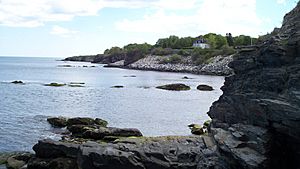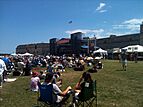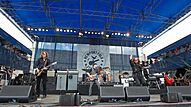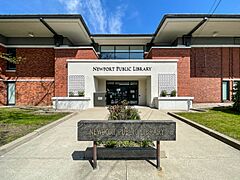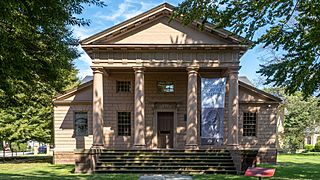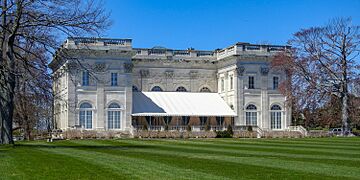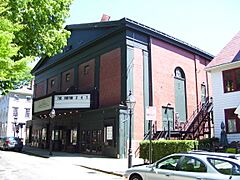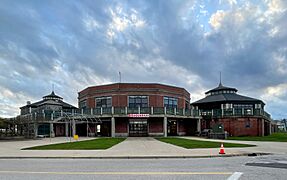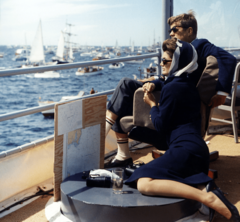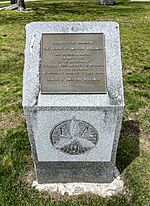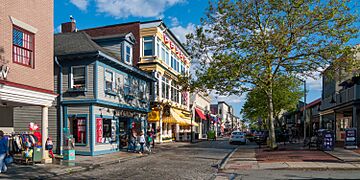Newport, Rhode Island facts for kids
Quick facts for kids
Newport
|
|||
|---|---|---|---|
|
City
|
|||
|
From top, left to right: Newport Harbor, The Breakers, White Horse Tavern, Cliff Walk, Old Colony House, Newport Tower
|
|||
|
|||
Nickname(s):
|
|||
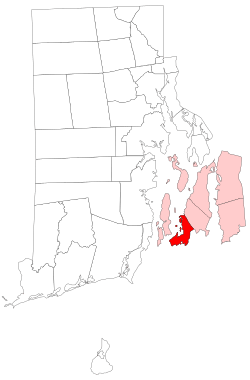
Location of Newport in Newport County, Rhode Island
|
|||
| Country | United States | ||
| State | Rhode Island | ||
| County | Newport | ||
| Incorporated (city) | 1784 | ||
| Incorporated (town) | 1639 | ||
| Area | |||
| • Total | 11.37 sq mi (29.46 km2) | ||
| • Land | 7.66 sq mi (19.83 km2) | ||
| • Water | 3.72 sq mi (9.63 km2) | ||
| Elevation | 26 ft (8 m) | ||
| Population
(2020)
|
|||
| • Total | 25,163 | ||
| • Density | 3,286.70/sq mi (1,269.03/km2) | ||
| Time zone | UTC−5 (EST) | ||
| • Summer (DST) | UTC−4 (EDT) | ||
| ZIP Codes |
02840–02841
|
||
| Area code(s) | 401 | ||
| FIPS code | 44-49960 | ||
| GNIS feature ID | 1217986 | ||
Newport is a beautiful city by the sea in Rhode Island, United States. It's located on Aquidneck Island in Narragansett Bay. Newport is famous for its amazing historic mansions and its long history with sailing. About 25,000 people live here.
This city has hosted big sports events like the first U.S. Open tournaments for tennis and golf. It was also the home of the America's Cup sailing races for many years. Newport is home to Salve Regina University and Naval Station Newport. This naval base includes the United States Naval War College and a major Navy training center. Newport was an important port city in the 1700s. Many buildings from the colonial era still stand today.
Newport is the main city of Newport County. It was also known as a "Summer White House" for presidents Dwight D. Eisenhower and John F. Kennedy.
Contents
History of Newport
How Newport Began
Newport was started in 1639 by eight founders. They included Nicholas Easton and William Coddington. These founders came from Portsmouth, Rhode Island. They left after disagreements with other settlers.
Newport quickly became the most important port in colonial Rhode Island. A public school was even started here in 1640.
Early Settlers and Religious Freedom
In 1658, a group of Jewish people settled in Newport. They were escaping persecution in Spain and Portugal. Their community, Congregation Jeshuat Israel, is the second-oldest Jewish group in the U.S. They meet at Touro Synagogue, the oldest synagogue building in the country.
In 1663, Rhode Island received its Royal Charter. This was a special document from the King. Benedict Arnold became the first Governor in Newport. The Old Colony House, built in 1741, was the government seat. It served until 1904 when Rhode Island State House in Providence became the only capital.
Newport's Growth as a Trading Hub
In the mid-1700s, more Portuguese Jewish families came to Newport. They brought business skills and helped Newport become a rich trading port. Jacob Rodrigues Rivera arrived in 1745. He started making sperm oil in America. This became a huge industry for Newport.
Aaron Lopez came from Lisbon in 1752. He helped Newport become a major trade center. He encouraged many Jewish families to settle there. Newport soon had many ships involved in trade. Lopez was a very wealthy man. He made candles, ships, and other goods. Sadly, he was not allowed to become a citizen in Rhode Island because he was Jewish. He eventually gained citizenship in Massachusetts.
Much of the city's business happened around Washington Square. This area was the heart of colonial Newport.
Quakers and Early Publications
Many Quakers also settled in Newport in the early 1700s. Their meetinghouse from 1699 is the oldest church building in Rhode Island.
In 1727, James Franklin, Benjamin's brother, printed in Newport. He started the first newspaper, the Rhode Island Gazette, in 1732. Later, his son started the weekly Mercury. Newport was also known for its beautiful furniture made by Goddard and Townsend. Today, Newport is famous for its 1800s mansions. It's also known for tall ships and sailing races.
Pirates and the Slave Trade
Newport was a big center for piracy in the late 1600s and early 1700s. Many pirates used it as their home base. Thomas Tew was a famous pirate who was popular with the locals.
By the 1720s, British officials pressured colonial leaders to arrest pirates. Many were hanged in Newport and buried on Goat Island.
During the colonial period, Newport was a major center for the slave trade in New England. Ships would carry sugar and molasses from the Caribbean to Rhode Island. There, it was made into rum. This rum was then traded for people in West Africa. These people were then forced into slavery. In 1764, Newport had 22 rum distilleries. Many wealthy families made their money from this trade. The Common Burial Ground is where most enslaved people were buried.
About 60% of slave-trading trips from North America started in Rhode Island. Many of these trips were illegal after 1787. Even after laws were passed to stop the slave trade, some people continued it. A few Rhode Island families became very rich from this. The D’Wolfs of Bristol, Rhode Island were the largest slave-trading family in North America. They made over 80 illegal trips. Many people in Rhode Island were involved in the slave trade, not just big merchants.
-
Touro Synagogue, America's oldest existing synagogue
Newport During the American Revolution
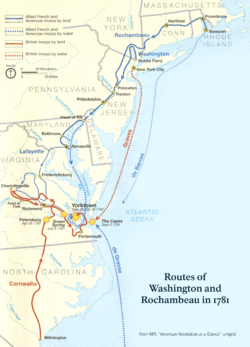
Newport was very active during the American Revolution. William Ellery from Newport signed the Declaration of Independence.
In 1775-1776, Rhode Island leaders tried to remove British supporters, called Loyalists, from Newport. In 1776, the British took over Newport. They wanted to use it as a naval base. Many people who supported American independence left the city. Newport was a British stronghold for three years.
In 1778, Americans tried to take back Newport in the Battle of Rhode Island. This was the first time American and French forces worked together. The French did not help as planned, and the British pushed the Americans off the island. The British left Newport the next year to focus on New York.
On July 10, 1780, a French army arrived in Newport. They were led by Rochambeau. Newport became the base for French forces in the U.S. In 1781, Rochambeau and General George Washington began their march to Yorktown, Virginia. The first Catholic mass in Rhode Island was held in Newport during this time. The Rochambeau Monument in Kings Park honors his help in the war.
Newport's population dropped from over 9,000 to less than 4,000 by 1783. The war destroyed Newport's economy. Many businesses closed, and merchants moved away.
In 1791, the Rhode Island General Assembly in Newport voted to approve the U.S. Constitution. This made Rhode Island the 13th state.
Newport was the home of Commodore Oliver Hazard Perry and the birthplace of Commodore Matthew C. Perry.
The Gilded Age in Newport
Starting in the mid-1800s, wealthy families began building summer homes in Newport. These were called "cottages," but they were actually huge mansions! Early mansions like Kingscote (1839) and Chateau-sur-Mer (1852) were built. Many of these families made their money from trade with China.
By the early 1900s, some of America's richest families spent summers in Newport. These included the Vanderbilts and Astors. They built the biggest "cottages" like The Breakers (1895). These homes had grand rooms for parties but few bedrooms. Guests were expected to have their own "cottages." Many homes were designed by architect Richard Morris Hunt.
The social life in Newport during this time is described in Edith Wharton's book The Age of Innocence. Her own Newport home was called Land's End. Today, many mansions are still private homes. Hammersmith Farm is where Jackie Kennedy got married. It was a museum but is now a private home again. Many other mansions are open for tours. Some were even turned into school buildings for Salve Regina College in the 1930s.
In the mid-1800s, many Irish immigrants settled in Newport. The Fifth Ward became a strong Irish neighborhood. Today, St. Patrick's Day is a big celebration in Newport with a parade.
The oldest Catholic church in Rhode Island is St. Mary's on Spring Street.
-
The Breakers, a famous Newport mansion
Newport in the 19th and 20th Centuries
Rhode Island used to have several capitals, including Newport. But in 1900, Providence became the only capital.
John Fitzgerald Kennedy and Jacqueline Bouvier were married at St. Mary's Church in Newport in 1953. Both President Kennedy and President Eisenhower used Newport as their "Summer White Houses." Eisenhower stayed at the Naval War College, and Kennedy used Hammersmith Farm.
In the 1900s, people from Portugal and the Caribbean also moved to Newport. This made the city even more diverse.
The city has a strong connection to the United States Navy. From 1952 to 1973, it was home to many U.S. Atlantic Fleet ships. It also hosted the U.S. Naval Academy during the American Civil War. Today, Newport has Naval Station Newport (NAVSTA Newport). It is also home to the U.S. Naval War College and a large part of the Naval Undersea Warfare Center.
When the Navy ships left Newport in 1973, it hurt the local economy. Businesses closed, and property values went down. However, in the late 1960s, the city started to rebuild. They built new stores and hotels. The Newport Bridge was completed. The Preservation Society of Newport County began opening the historic mansions to the public. Tourism then became Newport's main business.
Newport's Location and Weather
Newport is on Aquidneck Island in Narragansett Bay. It is the most populated town on the island. The city covers about 11.4 square miles (29.5 square kilometers). About 3.7 square miles (9.6 square kilometers) of this is water. The Newport Bridge connects Newport to Conanicut Island. It is the longest suspension bridge in New England.
Because it's surrounded by the ocean, Newport often has cooler summers than some other cities further north, like Boston.
| Climate data for Newport, Rhode Island (Rose Island Light), 1991–2020 normals, extremes 1957–2003 | |||||||||||||
|---|---|---|---|---|---|---|---|---|---|---|---|---|---|
| Month | Jan | Feb | Mar | Apr | May | Jun | Jul | Aug | Sep | Oct | Nov | Dec | Year |
| Record high °F (°C) | 65 (18) |
65 (18) |
74 (23) |
86 (30) |
89 (32) |
93 (34) |
96 (36) |
98 (37) |
93 (34) |
81 (27) |
73 (23) |
69 (21) |
98 (37) |
| Mean daily maximum °F (°C) | 38.6 (3.7) |
40.0 (4.4) |
45.9 (7.7) |
55.2 (12.9) |
64.8 (18.2) |
71.6 (22.0) |
77.4 (25.2) |
78.0 (25.6) |
72.9 (22.7) |
62.7 (17.1) |
53.0 (11.7) |
44.2 (6.8) |
58.7 (14.8) |
| Daily mean °F (°C) | 31.3 (−0.4) |
32.6 (0.3) |
38.8 (3.8) |
47.5 (8.6) |
56.7 (13.7) |
64.7 (18.2) |
70.8 (21.6) |
71.1 (21.7) |
66.1 (18.9) |
55.9 (13.3) |
46.2 (7.9) |
37.7 (3.2) |
51.6 (10.9) |
| Mean daily minimum °F (°C) | 23.9 (−4.5) |
25.1 (−3.8) |
31.7 (−0.2) |
39.7 (4.3) |
48.6 (9.2) |
57.7 (14.3) |
64.3 (17.9) |
64.1 (17.8) |
59.2 (15.1) |
49.1 (9.5) |
39.5 (4.2) |
31.3 (−0.4) |
44.5 (6.9) |
| Record low °F (°C) | −9 (−23) |
−3 (−19) |
3 (−16) |
10 (−12) |
21 (−6) |
37 (3) |
41 (5) |
41 (5) |
35 (2) |
26 (−3) |
11 (−12) |
−5 (−21) |
−9 (−23) |
| Average precipitation inches (mm) | 4.03 (102) |
3.57 (91) |
4.61 (117) |
4.73 (120) |
3.91 (99) |
3.17 (81) |
3.21 (82) |
3.29 (84) |
3.82 (97) |
4.72 (120) |
3.94 (100) |
4.45 (113) |
47.45 (1,205) |
| Average snowfall inches (cm) | 5.5 (14) |
9.1 (23) |
4.8 (12) |
1.3 (3.3) |
0.0 (0.0) |
0.0 (0.0) |
0.0 (0.0) |
0.0 (0.0) |
0.0 (0.0) |
0.0 (0.0) |
0.1 (0.25) |
5.2 (13) |
26.0 (66) |
| Average precipitation days (≥ 0.01 in) | 11.5 | 9.2 | 11.5 | 11.5 | 11.9 | 10.3 | 9.3 | 10.6 | 10.8 | 8.8 | 9.7 | 10.7 | 125.8 |
| Average snowy days (≥ 0.1 in) | 3.0 | 3.4 | 1.7 | 0.5 | 0.0 | 0.0 | 0.0 | 0.0 | 0.0 | 0.0 | 0.2 | 1.6 | 10.4 |
| Source: NOAA | |||||||||||||
| Climate data for Newport State Airport (2000–2020 normals, extremes Jul 1996–present) | |||||||||||||
|---|---|---|---|---|---|---|---|---|---|---|---|---|---|
| Month | Jan | Feb | Mar | Apr | May | Jun | Jul | Aug | Sep | Oct | Nov | Dec | Year |
| Record high °F (°C) | 67 (19) |
63 (17) |
74 (23) |
88 (31) |
91 (33) |
93 (34) |
98 (37) |
93 (34) |
91 (33) |
84 (29) |
73 (23) |
70 (21) |
98 (37) |
| Mean maximum °F (°C) | 55 (13) |
54 (12) |
63 (17) |
72 (22) |
81 (27) |
86 (30) |
89 (32) |
87 (31) |
83 (28) |
76 (24) |
66 (19) |
60 (16) |
91 (33) |
| Mean daily maximum °F (°C) | 38.1 (3.4) |
39.7 (4.3) |
45.7 (7.6) |
55.5 (13.1) |
65.0 (18.3) |
73.9 (23.3) |
79.6 (26.4) |
78.8 (26.0) |
72.3 (22.4) |
62.3 (16.8) |
52.5 (11.4) |
43.8 (6.6) |
58.9 (14.9) |
| Daily mean °F (°C) | 31.1 (−0.5) |
32.4 (0.2) |
38.3 (3.5) |
47.4 (8.6) |
56.8 (13.8) |
65.8 (18.8) |
71.8 (22.1) |
71.2 (21.8) |
64.7 (18.2) |
54.5 (12.5) |
45.2 (7.3) |
36.8 (2.7) |
51.3 (10.7) |
| Mean daily minimum °F (°C) | 24.1 (−4.4) |
25.1 (−3.8) |
30.8 (−0.7) |
39.3 (4.1) |
48.5 (9.2) |
57.8 (14.3) |
64.1 (17.8) |
63.6 (17.6) |
57.1 (13.9) |
46.8 (8.2) |
37.9 (3.3) |
29.9 (−1.2) |
43.8 (6.6) |
| Mean minimum °F (°C) | 6 (−14) |
10 (−12) |
16 (−9) |
29 (−2) |
37 (3) |
47 (8) |
55 (13) |
54 (12) |
45 (7) |
34 (1) |
23 (−5) |
14 (−10) |
4 (−16) |
| Record low °F (°C) | −6 (−21) |
−8 (−22) |
3 (−16) |
22 (−6) |
32 (0) |
42 (6) |
50 (10) |
49 (9) |
39 (4) |
28 (−2) |
15 (−9) |
5 (−15) |
−8 (−22) |
| Average precipitation inches (mm) | 3.21 (82) |
2.81 (71) |
4.57 (116) |
3.81 (97) |
3.03 (77) |
3.41 (87) |
2.93 (74) |
3.41 (87) |
3.44 (87) |
4.06 (103) |
3.76 (96) |
3.74 (95) |
42.18 (1,071) |
| Average precipitation days (≥ 0.01 in) | 10.0 | 9.2 | 10.2 | 11.3 | 12.6 | 11.8 | 10.3 | 10.1 | 10.2 | 11.7 | 9.3 | 11.1 | 127.8 |
| Source: NOAA | |||||||||||||
Newport's Population and People
| Historical population | ||
|---|---|---|
| Year | Pop. | ±% |
| 1708 | 2,203 | — |
| 1730 | 4,640 | +110.6% |
| 1748 | 6,508 | +40.3% |
| 1755 | 6,753 | +3.8% |
| 1774 | 9,209 | +36.4% |
| 1782 | 5,530 | −40.0% |
| 1790 | 6,716 | +21.4% |
| 1800 | 6,739 | +0.3% |
| 1810 | 7,907 | +17.3% |
| 1820 | 7,319 | −7.4% |
| 1830 | 8,010 | +9.4% |
| 1840 | 8,333 | +4.0% |
| 1850 | 9,563 | +14.8% |
| 1860 | 10,508 | +9.9% |
| 1870 | 12,521 | +19.2% |
| 1880 | 15,693 | +25.3% |
| 1890 | 19,457 | +24.0% |
| 1900 | 22,441 | +15.3% |
| 1910 | 27,149 | +21.0% |
| 1920 | 30,255 | +11.4% |
| 1930 | 27,612 | −8.7% |
| 1940 | 30,532 | +10.6% |
| 1950 | 37,564 | +23.0% |
| 1960 | 47,049 | +25.3% |
| 1970 | 34,562 | −26.5% |
| 1980 | 29,259 | −15.3% |
| 1990 | 28,227 | −3.5% |
| 2000 | 26,475 | −6.2% |
| 2010 | 24,672 | −6.8% |
| 2020 | 25,163 | +2.0% |
| Source: U.S. Decennial Census 2019 estimate 1708–1782 |
||
Newport's Population in 2020
The 2020 United States census counted 25,163 people in Newport. There were 10,898 households. About 75.9% of the people were white. About 5.9% were Black or African-American. Around 1.8% were Asian. About 11.8% of the population was Hispanic or Latino.
About 18.9% of households had children under 18. The average household had 2.1 people. The average family had 2.8 people. About 41% of the population had a college degree or higher.
The median age in Newport was 37.9 years old. For every 100 females, there were 106.4 males.
The median household income was about $68,201. The median family income was about $96,161. About 14.4% of the population lived below the poverty line. This included 25% of those under 18.
Newport's Culture and Landmarks
Historic Colonial Buildings
The Newport Historic District has many colonial homes. It is one of the most important historic areas in the country. Doris Duke, a wealthy heiress, started the Newport Restoration Foundation in 1968. She helped save and restore over 80 historic buildings in Newport.
The White Horse Tavern was built before 1673. It is one of the oldest taverns in the U.S. Newport is also home to the Touro Synagogue. This is one of the oldest Jewish places of worship in the Western Hemisphere. The city also has the nation's oldest lending library, the Redwood Library and Athenaeum.
Grand Gilded Age Mansions
Newport is also famous for its many Gilded Age mansions. These were huge summer "cottages" built by rich American families. They were built mostly between 1870 and 1915. Many look like royal palaces from Europe.
Some of these mansions are now museums. You can visit The Breakers (Vanderbilt family), Marble House (William Kissam Vanderbilt), and Rosecliff.
Music and Festivals
Newport is the hometown of The Cowsills, a pop group from the 1960s. The band Throwing Muses also started here.
Fort Adams State Park hosts two famous music events: the Newport Folk Festival and the Newport Jazz Festival. The Jazz Festival started in 1954. The Folk Festival began in 1959. Both festivals are held every year at Fort Adams. A famous moment happened at the Folk Festival in 1965 when Bob Dylan played electric guitar.
Newport in Movies
The Jane Pickens Theater is an old movie theater in downtown Newport. It was built as a church in 1834 and became a theater in 1922. It is now the only movie theater on Aquidneck Island.
Newport has been a filming location for many movies. These include High Society (1956), The Great Gatsby (1974), and Hocus Pocus 2 (2022).
Newport's Aquarium
The Hamilton Family Aquarium opened in March 2024. It is run by the non-profit group Save the Bay. This aquarium helps people learn about the ocean and local marine life.
-
Marble House, a famous mansion
Sports and Fun in Newport
Newport has a rich history in sports because it was a playground for the wealthy. The League of American Wheelmen started here in 1880. The first U.S. national tennis championships were held here in 1881. The first U.S. Open golf tournament was played in 1895. The America's Cup sailing races were held in Newport from 1930 to 1983.
Sailing in Newport
Newport is often called the "Sailing Capital of the World." The National Sailing Hall of Fame moved here in 2019. Many sailing clubs are based in the city. These include the New York Yacht Club.
Newport hosted the America's Cup sailing races for over 50 years. It is also the starting point for the Newport Bermuda Race. This race happens every two years.
Tennis in Newport
The Newport Casino was where the first American lawn tennis championships took place. Since 1954, it has been home to the International Tennis Hall of Fame. The Hall of Fame Open tennis tournament is held here every July. New members are also added to the Hall of Fame during this week.
Golf in Newport
Newport is home to the Newport Country Club. This club hosted the first U.S. Amateur Championship and the first U.S. Open in 1895. It also hosted the 2006 U.S. Women's Open.
Bicycling in Newport
In the late 1800s, bicycling became popular in Newport. In 1880, cycling clubs met in Newport to form the League of American Wheelmen. This was the first national bicycling group. The League helped create better roads for cycling.
In 2013, Newport was recognized as a "Bronze Bicycle Friendly Community."
Baseball in Newport
Downtown Newport has Cardines Field, one of the oldest ballparks in the country. Since 2001, it has been home to the Newport Gulls. This is a summer baseball team for college players.
Other Sports and Activities
Brenton Point State Park hosts an annual Kite Festival. The Citizens Bank Pell Bridge Run happens every fall. It raises money for local charities.
Beaches and Parks in Newport
Aquidneck Island has several beaches. The largest public beach is Easton's Beach, also called First Beach. It offers views of the Newport Cliff Walk. The Cliff Walk is a very popular attraction. It's a 3.5-mile (5.6 km) public walkway along the shoreline. It has been named a National Recreation Trail.
Sachuest Beach, or Second Beach, is in Middletown. It is the second-largest beach nearby. Gooseberry Beach is a private beach. However, it is open to the public on certain days. It is located on Ocean Drive. Other private beaches there include Bailey's Beach.
In 2014, Maya Lin, who designed the Vietnam Memorial, finished a renovation of Queen Anne Square Park. It is now called "The Meeting Room."
Education in Newport
Schools for Kids and Teens
Newport Public Schools runs the public schools. These include Claiborne Pell Elementary School, Thompson Middle School, and Rogers High School. The Pell School opened in 2013. It brought together several smaller elementary schools.
St. Michael's Country Day School is the only private elementary school in the city. There are other private schools nearby in Middletown and Portsmouth.
Colleges and Universities
Newport has several places for higher education. These include the Naval Academy Preparatory School, Salve Regina University, and Naval War College. The Community College of Rhode Island also has a campus here.
Newport's Economy
While technology and defense are big job areas, tourism is very important to Newport's economy. This includes hotels, restaurants, and shops. In 2013, almost 90% of jobs in Newport were in the service industry. Retail trade was the third largest job sector. Retail and restaurant jobs can increase by 1,500 during the busy summer season.
Major Employers in Newport
Here are some of the biggest employers in Newport:
| # | Employer | # of Employees |
|---|---|---|
| 1 | Naval Undersea Warfare Center | 4,200 |
| 2 | Lifespan Newport Hospital | 794 |
| 3 | City of Newport | 675 |
| 4 | Salve Regina University | 550 |
| 5 | Preservation Society of Newport County | 397 |
| 6 | Gurney's Newport Resort and Marina | 310 |
| 7 | Newport Restaurant Group | 299 |
| 8 | East Bay Community Action Program | 250 |
| 9 | Wyndham Hotels & Resorts | 250 |
| 10 | Marriott International | 185 |
Famous People from Newport
Sister Cities of Newport
Newport has several sister cities around the world:
 Imperia, Italy
Imperia, Italy Kinsale, Ireland
Kinsale, Ireland Ponta Delgada, Portugal
Ponta Delgada, Portugal Saint John, New Brunswick, Canada
Saint John, New Brunswick, Canada Shimoda, Japan
Shimoda, Japan Skiathos, Greece
Skiathos, Greece
See also
 In Spanish: Newport (Rhode Island) para niños
In Spanish: Newport (Rhode Island) para niños


















